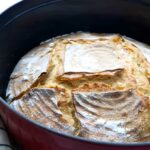Sourdough Einkorn Bread
A delicious rustic sourdough einkorn bread recipe that uses a natural sourdough starter. The ancient grain einkorn creates an amazing depth of flavor. This is real bread with real flavor.
Servings: 1 loaf
Ingredients
- ¾ cup active sourdough starter 180 grams, see notes
- 1 ⅔ to 1 ¾ cups warm water 392 to 413 grams
- 5 cups all-purpose einkorn flour 600 grams
- 2 teaspoons salt 12 grams
Instructions
- Mix the dough: In a large bowl, stir the starter into the warm water until fully dissolved. Add the flour and salt, and stir until it forms a rough, shaggy dough.
- Stretch and fold: After mixing, let the dough rest for 10 to 15 minutes. Then, with wet hands, grab one side of the dough, stretch it up, and fold it over to the opposite side. Rotate the bowl and repeat this motion 3 to 4 times, folding from a different side each time.Let the dough rest another 10 to 15 minutes, then repeat the stretch and fold process once more.
- Expect a sticky dough: The dough will be wet and sticky at this stage, that’s normal. Don’t add extra flour; it will make the bread dense. Wet your hands to keep the dough from sticking as you work with it.
- First rise (bulk fermentation): Let the dough rise at room temperature for 3 to 6 hours, until it increases by about 50% to 75%. This is your bulk fermentation stage.After the bulk rise, you’ll shape the dough and then do an optional cold proof (see below) to fit your schedule and boost flavor.
- Shape the dough: Turn the dough out onto a work surface and gently shape it into a round. If you're using a loaf pan, shape the dough into a log instead.
- Final proof: Place the shaped dough into a well-floured proofing basket or loaf pan. Cover and let it sit at room temperature for 1 to 2 hours to start the final proof, then transfer it to the fridge overnight or up to 15 hours.
- Einkorn sourdough should rise by about 50% to 75% before baking. Don’t let it double. If it hasn’t reached that after the cold proof, let it finish rising at room temperature. Keep an eye on it and move it to the oven once it hits that 50–75% mark to avoid over-proofing.
- Bake: Preheat your oven to 450°F. When it’s hot, gently tip the loaf into a Dutch oven or onto a baking sheet. Score the top with a sharp knife.If using a Dutch oven: cover for the first 30 minutes. Then remove the lid and bake for another 15–20 minutes, until the crust is golden and the loaf sounds hollow when tapped.
Notes
Rising times will vary depending on the temperature and humidity in your kitchen. You can slow the rise by placing the dough in the fridge, or speed it up by proofing in a warm room or dehydrator. A slower ferment develops more complex flavor.
If your fridge runs cold, the dough may not rise much during the final proof. That’s fine—just let it sit at room temperature after the cold proof until it rises by about 50–75% before baking. Or bake it straight from the fridge if it's ready.
For best results, weigh your ingredients with a kitchen scale. Measuring by volume can throw off the dough’s hydration and lead to inconsistent results.
Avoid adding flour to your countertop when kneading or shaping. Einkorn flour is delicate, and extra flour can make the bread dense. Wet your hands instead to prevent sticking.
Dust your proofing basket well. A 50/50 blend of rice flour and einkorn flour works best to prevent sticking. Regular flour absorbs moisture and may cause the dough to stick. If you don’t have a brotform, a bowl or colander works too.
A Dutch oven gives that classic crunchy crust, but if you don’t have one, you can bake the loaf directly on a baking sheet or hot pizza stone instead. You can even bake this bread in a loaf pan.
Nutrition
Serving: 1slice | Calories: 79kcal | Carbohydrates: 17g | Protein: 3g | Fat: 1g | Sodium: 142mg | Fiber: 2g
